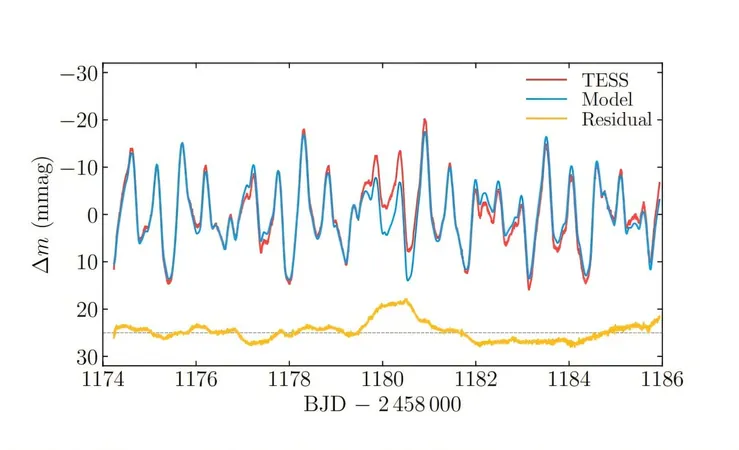
Groundbreaking Revelations about Double-Lined Spectroscopic Binary HD 34736
2024-11-20
Author: Li
Introduction
In an exciting new study released on November 6, 2023, scientists have unveiled groundbreaking insights into the double-lined spectroscopic binary known as HD 34736, located approximately 1,215 light-years away from Earth. This collaborative effort, led by astronomer Eugene Semenko from the National Astronomical Research Institute of Thailand, marks a significant advancement in our understanding of these complex stellar systems.
Understanding Spectroscopic Binaries
Spectroscopic binaries have intrigued astronomers for years, primarily observed through the Doppler effect, which reveals the shifting spectral lines of orbiting stars. Among these, double-lined spectroscopic binaries (SB2) like HD 34736 exhibit spectral lines from both stars, alternating between double and single lines as they orbit.
Unique Characteristics of HD 34736
What sets HD 34736 apart is its unique composition of two chemically peculiar late B-type stars. The primary star is particularly noteworthy, featuring a remarkable magnetic field exceeding 4.5 kG, while the secondary star boasts an effective temperature of 11,500 K and shows variability in its magnesium and silicon emission lines.
Research Methodology
Conducting a coordinated effort, the research team utilized various observing facilities across Europe, Asia, and North America to meticulously monitor this intriguing system. Their findings revealed that the primary star has a temperature of around 13,000 K and a rotational velocity of 75 km/s, while its companion star rotates more rapidly, exhibiting velocities between 110 and 180 km/s.
Orbital Dynamics and Rotational Periods
Further details from the study highlighted the orbital dynamics of these stars—HD 34736 features a highly eccentric orbit with an orbital period of 83.2 days. Interestingly, the primary star has a rotational period of about 1.28 days, which is gradually increasing by approximately 1.26 seconds per year. In contrast, the secondary star's rotational period is shorter, clocking in at around 0.52 days, but is decreasing by 0.14 seconds annually.
Magnetic Fields and Spectropolarimetric Data
One of the most visually striking observations was the primary star’s asymmetric global magnetic field, exhibiting strengths that fluctuate between -6.0 and 5.0 kG. For the secondary star, spectropolarimetric data suggested the presence of a weak magnetic field, offering hints at the complex intertwined nature of these celestial bodies.
Potential Third Component
Adding to the intrigue, researchers have proposed the potential existence of a third component within the HD 34736 system, which might be identified as a T Tauri variable star. Such findings could reshape our understanding of the system's evolution and dynamics, but further research is needed to confirm this tantalizing hypothesis.
Conclusion
This study not only advances our knowledge of binary star systems but also underscores the collaborative efforts of astronomers worldwide, demonstrating how international cooperation can unlock the secrets of the universe. As researchers continue to investigate the mysteries of HD 34736, the astronomical community watches with bated breath for further revelations that could enhance our understanding of stellar processes. Stay tuned for more cosmic discoveries that will leave you questioning everything you thought you knew about the universe!



 Brasil (PT)
Brasil (PT)
 Canada (EN)
Canada (EN)
 Chile (ES)
Chile (ES)
 España (ES)
España (ES)
 France (FR)
France (FR)
 Hong Kong (EN)
Hong Kong (EN)
 Italia (IT)
Italia (IT)
 日本 (JA)
日本 (JA)
 Magyarország (HU)
Magyarország (HU)
 Norge (NO)
Norge (NO)
 Polska (PL)
Polska (PL)
 Schweiz (DE)
Schweiz (DE)
 Singapore (EN)
Singapore (EN)
 Sverige (SV)
Sverige (SV)
 Suomi (FI)
Suomi (FI)
 Türkiye (TR)
Türkiye (TR)